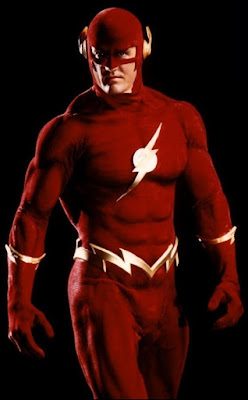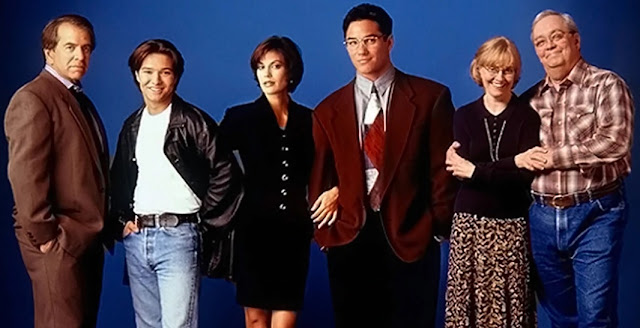 |
| Famed comics artist and Rocketeer creator, Dave Stevens, drew the concept art for the Flash costume. |
Tuesday, October 26, 2021
The Flash (1990) - Review and Analysis
Wednesday, October 20, 2021
Lois and Clark (1993-1997) - Review and Analysis
Debuting in 1993, Lois and Clark: The New Adventures of Superman was a television show that attempted to further the Superman legend by injecting romance into its super heroics. It ran for four seasons on ABC and followed the immediate Post-Crisis comic book continuity established by John Byrne et al. This was the first incarnation where Clark was the real identity and Superman was just a heroic persona.
Lois and Clark is a very entertaining show. The first season is the best, largely because of the dynamics between John Shea's Lex Luthor and Dean Cain's Superman. The plots of the show vary greatly. Action heavy stories give way to suspense. There's occasional cheesy comedy to balance out the romantic drama between the title characters, but it's the romance that really drives the show. The best episodes, for me, are when Superman's humanity is explored. The chemistry between Teri Hatcher and Dean Cain really draws you in and keeps you invested. The magic of the show really comes down to the cast.
Dean Cain is the best live-action Clark Kent ever. His Clark is the most fleshed out of any live-action version. Every time he is on screen he just exudes charm... Cain's Superman however, while very serviceable for a romantic adventure show, left a lot to be desired because there was very little to distinguish Cain's Superman from his Clark. For my money, the best Superman still is Christopher Reeve.Teri Hatcher delivers the definitive portrayal of Lois Lane. She defines every one of Lois' traits perfectly... the tough, brash, no-nonsense reporter. She's also very charming and sexy. If any of the other Lois' compare to her, the one that springs to my mind is Dana Delaney from Superman: The Animated Series in the 90's. Teri just nails Lois Lane perfectly.
Lane Smith as Perry White is just a complete character. Lane's Perry is very likable, funny, charming, and a genuinely good person who cares about his reporters. He's got the Elvis obsession that comes from the modern Perry from the comics. While I like John Hamilton (from the 1950's Superman show) and Jackie Cooper (the Reeve movies) in their roles, they don't get the rounded character of Perry as much as Lane Smith does. To be fair though, Lane Smith had four seasons to develop Perry into a real character.
Then there's Jimmy Olsen... Michael Landes did a good job with what he was offered but didnt get enough time to shine. He was good in the role but had he been given more time to develop, he probably would have been great. When I think of Jimmy Olsen, it's Justin Whalin that I think of. Whalin gave us the Daily Planet photographer as I'd always wanted to see him... curious, mischievous, a modern teenager.
Eddie Jones and Kay Kalin were great as The Kents. They seemed like the kind of parents (or grandparents) that you'd wanna have... just two very genuine and caring people... not too bland and old fashioned either, which was nice; a modern update on Ma and Pa Kent.
And now we come to my favorite part of the show: John Shea. His Lex Luthor was absolutely the most vile character and the perfect Lex Luthor. Arrogant, charismatic, narcissistic, and evil. His hatred for Superman is fiery. There were moments in that first season where he scared me. John Shea is the best Lex Luthor in live-action. He gave an absolutely stunning performance. No other Luthor compares in my mind, though Clancy Brown's Lex is the best animated version.
Tracy Scoggins as Cat Grant was interesting. Rather than giving fans the character from the books, they rewrote her as the office gossip. Tracy was great in the role, even if it was a different character. They axed her after the first season and she deserved better. They could have given her a credible exit, at the very least.
I also liked the character of Jack from Season 1 and would have preferred if he'd stuck around for the rest of the series. He was a cool addition to the cast.
Beyond the cast is the writing and production design. Lois and Clark features pretty conventional writing for a 1990's superhero TV series that turned into a romantic comedy/drama. The plots are fun and try to juggle human drama, light comedy, and comic book/sci-fi themes. Even if the budget doesn't always allow for the greatest effects work, the show holds up. I also think the production design was stellar. Dean Cain's Superman costume looked great on screen and every setting, from the Kent farm to the Daily Planet, even Luthor's penthouse, was spectacular.








